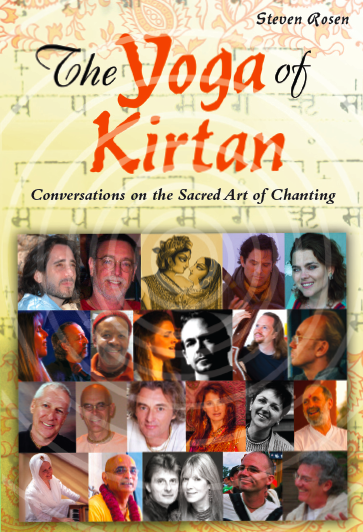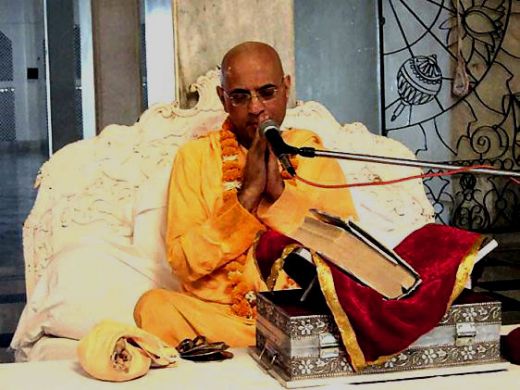An excerpt from Steven Rosen’s new book The Yoga of Kirtan – Conversations on the Sacred Art of Chanting.
Steven Rosen: In our remaining time, can you talk a little more about kirtan? I know this is actually the center of your current practice and also the main theme of your recent temple, opened in Ujjain.
Bhakti Charu Swami: The way I understand it, kirtan is actually a prayer to the Lord. Originally, those prayers were very personal, when initially composed. And then they take on more general expression, and anyone can chant it. But, early on, these were confidential prayers, like the mantras in the Vedas, where they are not open to the general public. Those mantras – like Gayatri, for example – were meant for meditative chanting, but they were circumscribed, only for special clientele, so to speak..
Now, Chaitanya Mahaprabhu came to give a different idea. He gave the maha-mantra openly, saying it was for everyone and anyone. So, for the first time, such mantras became public. And it was presented as both for personal meditation and for loud chanting, which enabled practitioners to share it with others. The loud chanting is generally known as Nama-sankirtana. This refers to congregational chanting, many people getting together – the more the merrier – to glorify the name of God. This makes it even more effective, more powerful. That is the yuga-dharma, the method of spiritual practice for this current time period, called Kali-yuga, as taught by Chaitanya Mahaprabhu.
He explained that people in this age are not qualified for any other yogic process. They won’t be able to meditate; they won’t be able to perform sacrifice; they won’t even be able to worship the deity of the Lord in the temple. What to speak of worshipping the deity, they won’t even be inclined to go to the temple. That’s the state of this age, the condition of this age. Therefore, Chaitanya Mahaprabhu inaugurated this Nama-sankirtana – a simple process – allowing everyone to get involved in this chanting of the holy name of the Lord.
So that is the origin of kirtan in our present age. After that, Mahaprabhu and his followers spread it throughout India. For example, in the following generation, great teachers, like Shrinivas Acharaya, Narottama Das Thakur, Syamananda Prabhu, and others took this movement further with newly developed chanting styles and traveling Sankirtan parties. They were preaching through music and story telling. People in those days were a bit more refined, in a sense, than people today. They could sit together day and night, just hearing descriptions of Chaitanya Mahaprabhu’s pastimes, the descriptions of Krishna’s pastimes. They were cultured, able to relish transcendental topics through drama, music, and so on.
Steven Rosen: Yes, this was the age of Padavali kirtan, spiritual song and narrative melded as one.
Bhakti Charu Swami: This is how it started, and as a result, Mahaprabhu’s movement spread like wildfire. Great devotees traveled throughout the countryside, expressing the Lords pastimes with sophisticated forms of song and dance, with dramatic performance and other developed artistic presentations. Because it was a cultural presentation, it was patronized by powerful kings and other influential individuals. Therefore, this is seen as a golden age of the Sankiritan movement.
***
Bhakti Charu Swami: You see, kirtan ultimately means glorifying the Lord. How we glorify him is up to us. And this glorification is an expression of our love for him. First through words: Chanting – “Hare Krsna, Hare Krsna, Krsna Krsna, Hare Hare” – is actually a prayer to Krsna. It means, “ Oh all attractive Supreme Personality of Godhead, Please allow me to love you, allow me to serve you.” Or, as George Harrison sang, “I really want to see you, I really want to be with you, my Lord….” This is the maha mantra – to pray to the Lord, to humbly asked to be engaged in his service. And then we do kirtan through action. But first comes chanting. And when we chant or sing this kirtan, whether by ourselves or collectively, it should be done as a prayer. We must offer all our love to him, fully recognizing his love for us. He has given us so much. He is taking care of us in so many wonderful ways. He is going with us wherever we go, in all forms of life. He is always with us as the supersoul, in our hearts of hearts. And as we become aware of this fact, as spontaneious love for him grows in our hearts, and we, just as naturally, want to express that love through all our words, through all our prayers, and through all our actions. That is the real kirtan. That is sankirtana.
(Bhakti Charu Swami, a native Bengali, was born in 1945 and spent most of his early life in urban Calcutta, where kirtan is a way of life. A Vaishnava scholar and Sanyasin, he was initiated into the Gaudiya Sampradaya by Sri A.C. Bhaktivedanta Swami Prabhupada in 1976. Along side his official responsibilities as a leader and ecclesiastical authority within the International Society for Krishna Consciousness, Bhakti Charu Swami has translated all of Srila Prabhupada’s works, consisting of more than fifty volumes of books, into Bengali, as Srila Prabhupada had instructed in their very first meeting. At present he is developing projects in Ujjain, India.)
Ordering information For “Yoga of Kirtan”:US$29.95Add $5 for shipping and handling
Send Check or Money Order Payable to:FOLK Books, P.O. Box 108, Nyack, NY 10960, U.S.A
For More Information:
[email protected] www.yogaofkirtan.com
Related Posts: New Book on Kirtan

